Alniyat, Sigma Scorpii (σ Sco), is the primary component in a multiple star system located approximately 568 light-years away in the constellation Scorpius. With a mass 18 times that of the Sun, the star is a supernova candidate. It is one of the two relatively bright stars that flank Antares, one of the brightest stars in the night sky.
Star system
The Sigma Scorpii star system consists of four components, designated Sigma Scorpii Aa1, Aa2, Ab, and B.
The primary component, Sigma Scorpii Aa1 (formally known as Alniyat) is a hot blue giant star of the spectral type B1 III. It has a mass 18.4 times that of the Sun and a radius 12.7 times the Sun’s. With an effective temperature of 26,150 K, it is about 29,000 times more luminous than the Sun. The star spins at 25 km/s. It has an estimated age of only 8 million years.
Even though it is a young star, Alniyat has already evolved away from the main sequence and will soon (astronomically speaking) meet its end as a fiery supernova. Massive stars take only millions of years to burn through their supply of fuel. They evolve quickly due to their high mass and keep fusing heavier elements until they develop iron cores. At this point, their core collapses, triggering a supernova event.
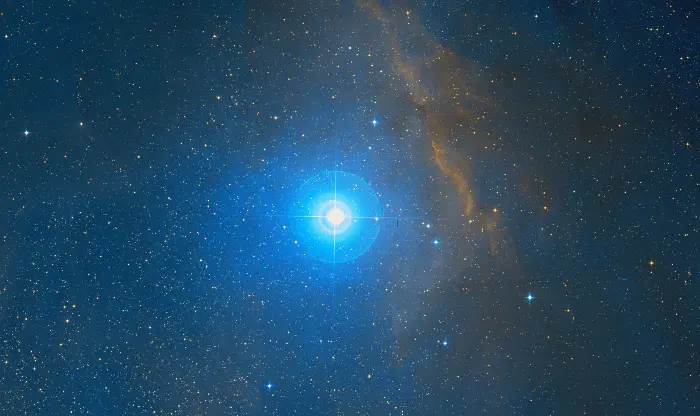
Alniyat (Sigma Scorpii), image: Wikisky
Alniyat is classified as a Beta Cephei variable. Beta Cephei stars exhibit small brightness variations due to pulsations. They are typically hot blue stars with masses between 7 and 20 solar masses. Bright members of this class include Mimosa (Beta Crucis) in the constellation Crux, Hadar (Beta Centauri) in Centaurus, Spica (Alpha Virginis) in Virgo, Shaula (Lambda Scorpii) in Scorpius, Alpha Lupi in Lupus, Algenib (Gamma Pegasi) in Pegasus, and Mirzam (Beta Canis Majoris) in Canis Major.
The brightness of Alniyat changes between magnitude 2.86 and 2.94 with multiple pulsation periods, some as short as a quarter of a day and others as long as years. The star also exhibits changes in temperature of about 4,000 K during each pulsation cycle.
Alniyat is part of a double-lined spectroscopic binary system. Its close companion, Sigma Scorpii Aa2, is also massive enough to be a supernova candidate. It is a main sequence star of the spectral type B1 V with a mass of 11.9 solar masses and a radius 9 times that of the Sun. It shines with around 16,000 solar luminosities. The two stars complete an orbit every 33.010 ± 0.002 days. The system has an eccentricity of 0.32 and a semi-major axis of only 3.62 milliarcseconds.
Sigma Scorpii Ab is separated by 0.4 arcseconds from the main pair. This corresponds to a physical separation of 120 or more astronomical units. It shines at magnitude 5.2 and orbits the main pair with a period of over a hundred years.
Sigma Scorpii B appears about 20 arcseconds away. It is a main sequence star of the spectral type B9. It has a visual magnitude of 8.7, well below unaided eye visibility.
Facts
Even though it is fairly bright, Alniyat is only the 11th brightest star in Scorpius. It is only slightly fainter than Fang in the Scorpion’s claws. It is about as bright as Albireo, the star that marks the Swan’s beak in Cygnus, and Sadalsuud, the brightest star in Aquarius.
Like many other bright stars in Scorpius, Alniyat is a member of the Upper Scorpius subgroup of the Scorpius-Centaurus association, the nearest OB association to the solar system. The members of the Upper Scorpius subgroup have a mean age of 11 million years. They include Antares (Alpha Scorpii), Dschubba (Delta Scorpii), Acrab (Beta Scorpii), Fang (Pi Scorpii), Paikauhale (Tau Scorpii), Iklil (Rho Scorpii), and Pipirima (Mu2 Scorpii) in the constellation of Scorpius, and Theta and Zeta Ophiuchi in the neighbouring Ophiuchus.
Name
The name Alniyat (pronunciation: /ælˈnaɪjæt/) comes from the Arabic al-niyāţ, meaning “the arteries.” The name refers to the star’s proximity to Antares, the star marking the Scorpion’s heart. Alniyat appears just north of the red supergiant. The two stars lie at similar distances from Earth but are not physically related.
The name Alniyat was traditionally also spelled Al Niyat. Sigma Scorpii historically shared it with Tau Scorpii, the other star flanking Antares. Tau Scorpii is now formally known as Paikauhale.
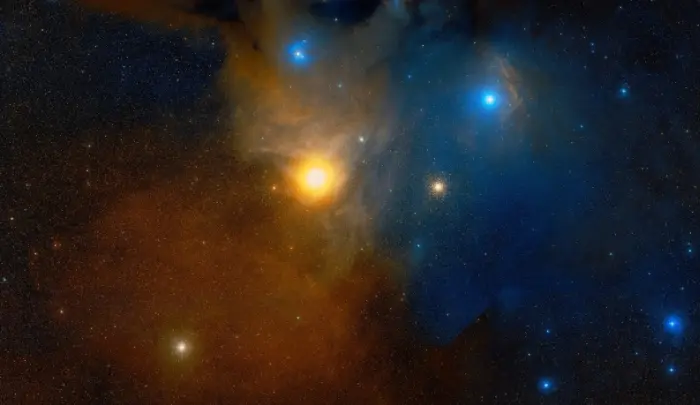
Antares, Alniyat and Paikauhale, image: Wikisky
The name Alniyat was approved by the International Astronomical Union’s (IAU) Working Group on Star Names (WGSN) on February 1, 2017. It formally applies only to the component Sigma Scorpii Aa1 but has traditionally been used for the whole star system.
In Chinese astronomy, Sigma Scorpii was known as 心宿一 (Xīn Xiù yī), the First Star of Heart. It was part of the Heart asterism along with Antares (Alpha Scorpii) and Paikauhale (Tau Scorpii). The asterism was part of the larger Heart mansion, which represented the heart of the Azure Dragon.
In the lore of the Boorong people of northwestern Victoria in Australia, Alniyat and Paikauhale were seen as wives of Djuit, represented by Antares.
Location
Alniyat is very easy to find because it lies near Antares, the 15th brightest star in the sky. Both stars lie near the bright band of the Milky Way galaxy. For northern observers, they appear above the southern horizon.
Some observers consider Alniyat to be part of the Fish Hook asterism, which curves all the way to the Scorpion’s stinger. The star appears in the region between Antares and Dschubba, the middle of the three brighter stars that mark the Scorpion’s claws.
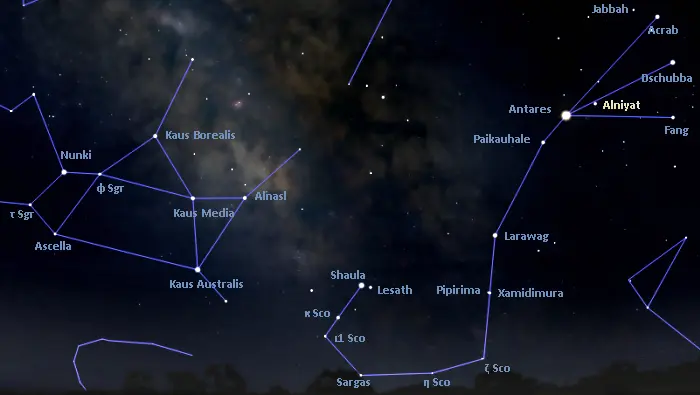
The location of Alniyat (Sigma Scorpii), image: Stellarium
Antares and Alniyat can be used to find the bright globular cluster Messier 4. The cluster lies 1.3 degrees west of Antares. With an apparent magnitude of 5.6 and apparent size of 26 arcminutes, it is visible in binoculars and small telescopes. It lies 6,033 light-years away.
The blue reflection nebula IC 4603 appears in the same area of the sky, in the neighbouring constellation Ophiuchus. It is part of the larger Rho Ophiuchi cloud complex, one of the nearest star forming regions to the solar system.
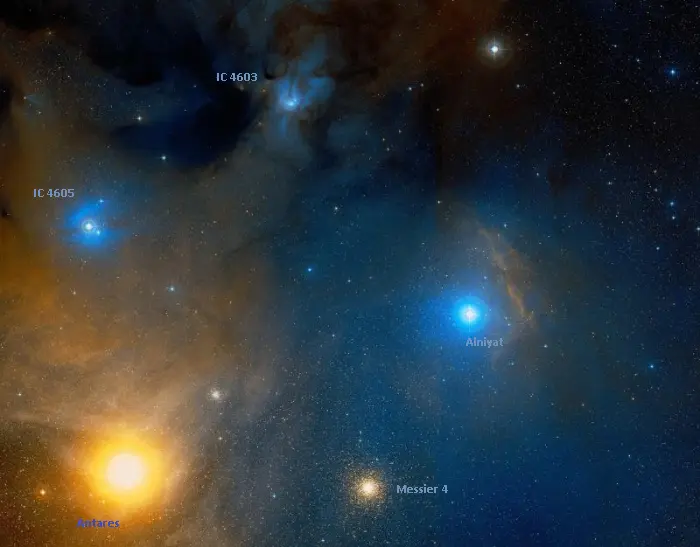
Antares, Alniyat, Messier 4, IC 4603 and IC 4605, image: Wikisky
Constellation
Alniyat is located in the constellation Scorpius. Scorpius is one of the ancient constellations catalogued by Claudius Ptolemy of Alexandria in his Almagest in the 2nd century CE. Like all zodiac constellations, it lies on the ecliptic, the Sun’s apparent path across the sky. In Greek mythology, the constellation is associated with the scorpion sent by the goddess Gaia to sting Orion.
The celestial Scorpion occupies 497 square degrees of the southern sky and is the 33rd largest of the 88 constellations. It is one of the easiest constellations to recognize because it looks just like the animal it represents. The red supergiant Antares marks the Scorpion’s heart and connects the claws with the curved line of stars that outline the Scorpion’s body and tail.
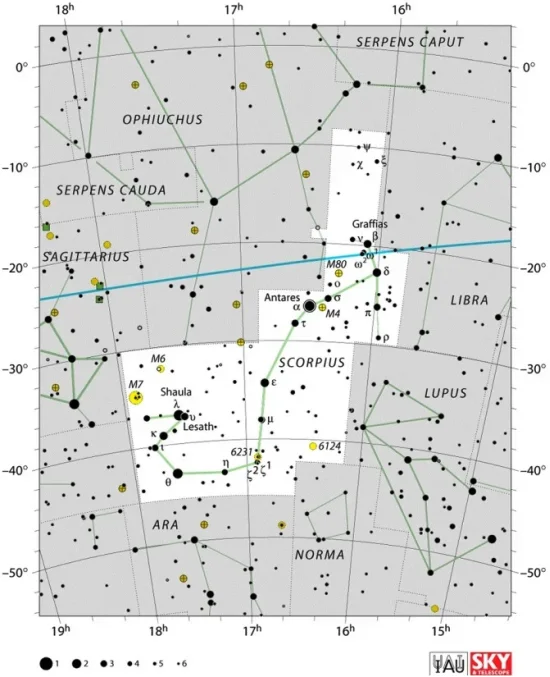
Scorpius constellation map by IAU and Sky&Telescope magazine
In addition to the bright Antares, notable stars in Scorpius include the orange giant Larawag, the supergiants Iota1 and Iota2 Scorpii, the binary stars Theta Scorpii (Sargas) and Kappa Scorpii, the blue subgiant Lesath (Upsilon Scorpii), the recurrent nova U Scorpii, and the multiple star systems Lambda Scorpii (Shaula), Beta Scorpii (Acrab), Delta Scorpii (Dschubba), and Pi Scorpii (Fang).
Scorpius hosts many bright deep sky objects. The best-known ones include the open clusters Messier 6 and Messier 7 (the Butterfly Cluster and the Ptolemy Cluster), the Northern Jewel Box Cluster (NGC 6231), the star forming nebulae popularly known as the Cat’s Paw Nebula (NGC 6334) and the Lobster Nebula (NGC 6357), the reflection nebula IC 4592 (the Blue Horsehead Nebula), the planetary nebula NGC 6302 (the Butterfly Nebula), and the bright globular clusters Messier 4 and Messier 80.
The best time of the year to see the stars and deep sky objects in Scorpius is during the month of July, when the constellation rises higher above the horizon in the evening. The entire constellation is visible from locations south of the latitude 40° N.
The 10 brightest stars in Scorpius are Antares (Alpha Sco A, mag. 0.6 – 1.6), Shaula (Lambda Sco A, mag. 1.62), Sargas (Theta Sco A, mag. 1.84), Dschubba (Delta Sco, mag 2.307), Larawag (Epsilon Sco, mag. 2.31), Kappa Scorpii (mag. 2.39), Acrab (Beta Sco, mag. 2.62), Lesath (Upsilon Sco, mag. 2.70), Paikauhale (Tau Sco, mag. 2.82), and Fang (Pi Sco, mag. 2.89).
Alniyat – Sigma Scorpii
| Spectral class | B1 III + B1 V |
| Variable type | Beta Cephei |
| U-B colour index | −0.70 |
| B-V colour index | +0.13 |
| Apparent magnitude | 2.88 |
| Absolute magnitude | −4.12 ± 0.34 / −3.32 ± 0.34 |
| Distance | 568 light-years (509-643 ly); 174 parsecs (156-197 pc) |
| Parallax | 4.68 ± 0.60 mas |
| Radial velocity | -0.4 ± 0.9 km/s |
| Proper motion | RA: −10.60 ± 0.78 mas/yr |
| Dec.: −16.28 ± 0.43mas/yr | |
| Constellation | Scorpius |
| Right ascension | 16h 21m 11.3157134s |
| Declination | −25° 35′ 34.051476″ |
| Names and designations | Alniyat, Sigma Scorpii, σ Sco, 20 Scorpii, Al Niyat, Pekehāwani, HD 147165, HR 6084, HIP 80112, SAO 184336, FK5 607, CD-25 11485, GC 21982, GCRV 9404, CPD-25 5785, CSV 101578, PPM 265440, EUVE J1621-25.5, JP11 2729, UBV 13858, SH 2-9, GUM 65, LBN 1101, LBN 351.12+17.17, MCW 559, IRAS 16181-2528, 2MASS J16211131-2535342, TYC 6798-540-1, Gaia DR2 6048602103659567488, Gaia DR3 6048602103663486592, ADS 10009, CCDM J16212-2536A, IDS 16151-2521 A, WDS 16212-2536 |
Sigma Scorpii Aa1
| Mass | 18.4 ± 5.4 M☉, 17.2-18.0 M☉ |
| Luminosity | 29,000 ± 8,000 L☉, 95,500 L☉ |
| Radius | 12.7 ± 1.8 R☉ |
| Temperature | 26,150 ± 1,070 K, 27,700 K |
| Metallicity | −0.20 ± 0.20 dex |
| Age | 8.0 ± 0.2 million years, 8-10 million years |
| Rotational velocity | 25 km/s |
| Surface gravity | 3.85 cgs |
Sigma Scorpii Aa2
| Mass | 11.9 ± 3.1 M☉ |
| Luminosity | 16,000 ± 4,000 L☉ |
| Radius | 11 R☉ |